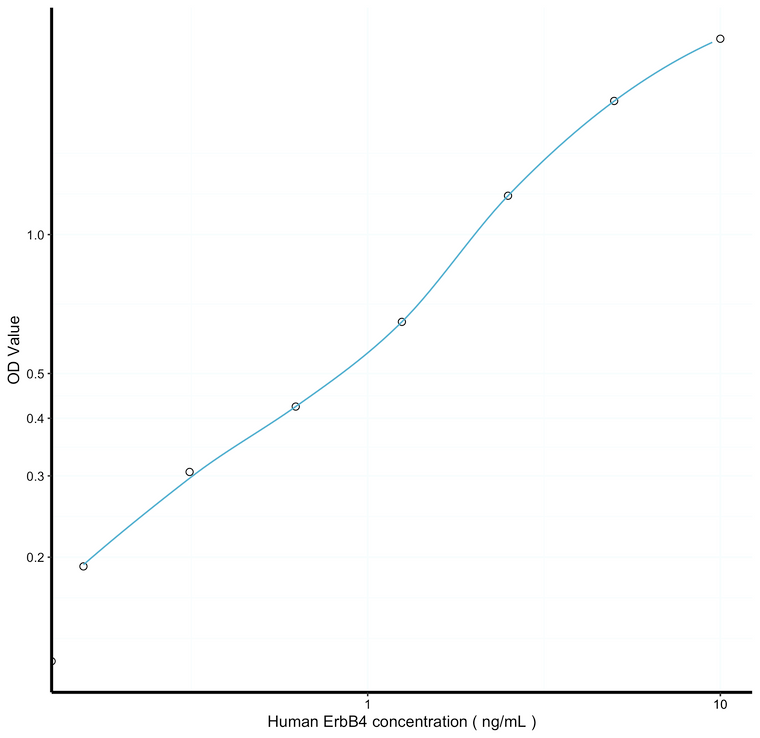| Tissue Specificity | Expressed at highest levels in brain, heart, kidney, in addition to skeletal muscle, parathyroid, cerebellum, pituitary, spleen, testis and breast. Lower levels in thymus, lung, salivary gland, and pancreas. Isoform JM-A CYT-1 and isoform JM-B CYT-1 are expressed in cerebellum, but only the isoform JM-B is expressed in the heart. |
| Post Translational Modifications | Isoform JM-A CYT-1 and isoform JM-A CYT-2 are processed by ADAM17. Proteolytic processing in response to ligand or 12-O-tetradecanoylphorbol-13-acetate stimulation results in the production of 120 kDa soluble receptor forms and intermediate membrane-anchored 80 kDa fragments (m80HER4), which are further processed by a presenilin-dependent gamma-secretase to release a cytoplasmic intracellular domain (E4ICD.E4ICD1/s80Cyt1 or E4ICD2/s80Cyt2, depending on the isoform). Membrane-anchored 80 kDa fragments of the processed isoform JM-A CYT-1 are more readily degraded by the proteasome than fragments of isoform JM-A CYT-2, suggesting a prevalence of E4ICD2 over E4ICD1. Isoform JM-B CYT-1 and isoform JM-B CYT-2 lack the ADAM17 cleavage site and are not processed by ADAM17, precluding further processing by gamma-secretase. Autophosphorylated on tyrosine residues in response to ligand binding. Autophosphorylation occurs in trans, i.e. one subunit of the dimeric receptor phosphorylates tyrosine residues on the other subunit. Ligands trigger phosphorylation at specific tyrosine residues, thereby creating binding sites for scaffold proteins and effectors. Constitutively phosphorylated at a basal level when overexpressed in heterologous systems.ligand binding leads to increased phosphorylation. Phosphorylation at Tyr-1035 is important for interaction with STAT1. Phosphorylation at Tyr-1056 is important for interaction with PIK3R1. Phosphorylation at Tyr-1242 is important for interaction with SHC1. Phosphorylation at Tyr-1188 may also contribute to the interaction with SHC1. Isoform JM-A CYT-2 is constitutively phosphorylated on tyrosine residues in a ligand-independent manner. E4ICD2 but not E4ICD1 is phosphorylated on tyrosine residues. Ubiquitinated. During mitosis, the ERBB4 intracellular domain is ubiquitinated by the APC/C complex and targeted to proteasomal degradation. Isoform JM-A CYT-1 and isoform JM-B CYT-1 are ubiquitinated by WWP1. The ERBB4 intracellular domain (E4ICD1) is ubiquitinated, and this involves NEDD4. |
| Function | Tyrosine-protein kinase that plays an essential role as cell surface receptor for neuregulins and EGF family members and regulates development of the heart, the central nervous system and the mammary gland, gene transcription, cell proliferation, differentiation, migration and apoptosis. Required for normal cardiac muscle differentiation during embryonic development, and for postnatal cardiomyocyte proliferation. Required for normal development of the embryonic central nervous system, especially for normal neural crest cell migration and normal axon guidance. Required for mammary gland differentiation, induction of milk proteins and lactation. Acts as cell-surface receptor for the neuregulins NRG1, NRG2, NRG3 and NRG4 and the EGF family members BTC, EREG and HBEGF. Ligand binding triggers receptor dimerization and autophosphorylation at specific tyrosine residues that then serve as binding sites for scaffold proteins and effectors. Ligand specificity and signaling is modulated by alternative splicing, proteolytic processing, and by the formation of heterodimers with other ERBB family members, thereby creating multiple combinations of intracellular phosphotyrosines that trigger ligand- and context-specific cellular responses. Mediates phosphorylation of SHC1 and activation of the MAP kinases MAPK1/ERK2 and MAPK3/ERK1. Isoform JM-A CYT-1 and isoform JM-B CYT-1 phosphorylate PIK3R1, leading to the activation of phosphatidylinositol 3-kinase and AKT1 and protect cells against apoptosis. Isoform JM-A CYT-1 and isoform JM-B CYT-1 mediate reorganization of the actin cytoskeleton and promote cell migration in response to NRG1. Isoform JM-A CYT-2 and isoform JM-B CYT-2 lack the phosphotyrosine that mediates interaction with PIK3R1, and hence do not phosphorylate PIK3R1, do not protect cells against apoptosis, and do not promote reorganization of the actin cytoskeleton and cell migration. Proteolytic processing of isoform JM-A CYT-1 and isoform JM-A CYT-2 gives rise to the corresponding soluble intracellular domains (4ICD) that translocate to the nucleus, promote nuclear import of STAT5A, activation of STAT5A, mammary epithelium differentiation, cell proliferation and activation of gene expression. The ERBB4 soluble intracellular domains (4ICD) colocalize with STAT5A at the CSN2 promoter to regulate transcription of milk proteins during lactation. The ERBB4 soluble intracellular domains can also translocate to mitochondria and promote apoptosis. |
| Protein Name | Receptor Tyrosine-Protein Kinase Erbb-4Proto-Oncogene-Like Protein C-Erbb-4Tyrosine Kinase-Type Cell Surface Receptor Her4P180erbb4 Cleaved Into - Erbb4 Intracellular Domain4icdE4icdS80her4 |
| Database Links | Reactome: R-HSA-1227986Reactome: R-HSA-1236394Reactome: R-HSA-1250196Reactome: R-HSA-1250342Reactome: R-HSA-1250347Reactome: R-HSA-1251985Reactome: R-HSA-1253288Reactome: R-HSA-1257604Reactome: R-HSA-1963640Reactome: R-HSA-1963642Reactome: R-HSA-2219530Reactome: R-HSA-5673001Reactome: R-HSA-6785631Reactome: R-HSA-6811558Reactome: R-HSA-8847993Reactome: R-HSA-8863795Reactome: R-HSA-9018519Reactome: R-HSA-9620244Reactome: R-HSA-9664565Reactome: R-HSA-9665686 |
| Cellular Localisation | Cell MembraneSingle-Pass Type I Membrane ProteinIn Response To Nrg1 TreatmentThe Activated Receptor Is InternalizedErbb4 Intracellular Domain: NucleusMitochondrionFollowing Proteolytical Processing E4icd (E4icd1 Or E4icd2 Generated From The Respective Isoforms) Is Translocated To The NucleusSignificantly More E4icd2 Than E4icd1 Is Found In The NucleusE4icd2 Colocalizes With Yap1 In The Nucleus |
| Alternative ELISA Names | Receptor Tyrosine-Protein Kinase Erbb-4 ELISA kitProto-Oncogene-Like Protein C-Erbb-4 ELISA kitTyrosine Kinase-Type Cell Surface Receptor Her4 ELISA kitP180erbb4 Cleaved Into - Erbb4 Intracellular Domain ELISA kit4icd ELISA kitE4icd ELISA kitS80her4 ELISA kitERBB4 ELISA kitHER4 ELISA kit |
| output | |







